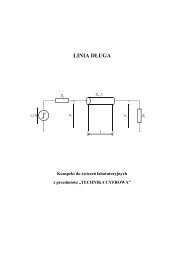9 Interlayer Exchange Interactions in Magnetic Multilayers
9 Interlayer Exchange Interactions in Magnetic Multilayers
9 Interlayer Exchange Interactions in Magnetic Multilayers
Create successful ePaper yourself
Turn your PDF publications into a flip-book with our unique Google optimized e-Paper software.
332 9 <strong>Interlayer</strong> <strong>Exchange</strong> <strong>Interactions</strong> <strong>in</strong> <strong>Magnetic</strong> <strong>Multilayers</strong><br />
to be essential for successfully reveal<strong>in</strong>g full richness of thickness variation of the<br />
<strong>in</strong>terlayer exchange coupl<strong>in</strong>g.<br />
In particular, <strong>in</strong> confirmation of theoretical predictions (see below) it has been<br />
found experimentally that multiperiodic oscillatory coupl<strong>in</strong>g exists <strong>in</strong> Fe/Au(001)/Fe<br />
[17–19], Co/Cu(001)/Co [20–22], and Fe/Ag(001)/Fe [23] multilayers.<br />
The dependence on spacer thickness of the coupl<strong>in</strong>g constant J can therefore<br />
generally be expressed as:<br />
J = <br />
α<br />
Aα<br />
D 2 s<strong>in</strong> (qα D + φα) (2)<br />
where the <strong>in</strong>dex α labels the various oscillatory components. The strength of <strong>in</strong>terlayer<br />
exchange coupl<strong>in</strong>g, as expressed by Aα (which the dimension of an energy), is<br />
typically of the order of 1 to 10 meV, which (for a spacer thickness of 1 nm) corresponds<br />
to a value of the order of 0.1 to 1 mJ m −2 for the coupl<strong>in</strong>g constant J.<br />
Although the greatest dependence on thickness is the dependence on spacer<br />
layer thickness, (weak) oscillatory dependence on magnetic layer thickness has<br />
been observed for the Co/Cu(001)/Co system by Bloemen et al. [24] and for the<br />
Fe/Cu(001)/Co system by Back et al. [25], and dependende on the thickness of a<br />
non-magnetic coverage layer has been observed for the Co/Cu(001)/Co system by<br />
de Vries et al. [26], for the Fe/Au(001)/Fe system by Okuno and Inomata [27], and<br />
for the Co/Au(111)/Co system by Bounouh et al. [28], <strong>in</strong> accordance with theoretical<br />
predictions (see below for a detailed discussion).<br />
Although the most frequent behavior for the <strong>in</strong>terlayer exchange coupl<strong>in</strong>g is of the<br />
form given by Eq. (1), Rührig et al. [29] have observed <strong>in</strong> the Fe/Cr(001)/Fe system<br />
a special k<strong>in</strong>d of coupl<strong>in</strong>g <strong>in</strong> which the magnetization of successive magnetic layers<br />
tends to be perpendicular to each other, rather than either parallel or antiparallel,<br />
as follows from Eq. (1). This behavior can be understood if one assumes that the<br />
coupl<strong>in</strong>g is of the form<br />
E(θ) = J1 cos θ + J2 cos 2 θ (3)<br />
In comb<strong>in</strong>ation with the effect of cubic magnetocrystall<strong>in</strong>e anisotropy, the above<br />
coupl<strong>in</strong>g can, <strong>in</strong>deed, lead to a 90 degree configuration for suitable values of the<br />
coupl<strong>in</strong>g constants J1 and J2. This effect has been observed <strong>in</strong> other systems also. This<br />
additional coupl<strong>in</strong>g contribution is often dubbed “biquadratic” coupl<strong>in</strong>g. Although<br />
such coupl<strong>in</strong>g can, <strong>in</strong> pr<strong>in</strong>ciple, arise from <strong>in</strong>tr<strong>in</strong>sic mechanism, this effect is usually<br />
too small to expla<strong>in</strong> the experimental observations, and it is believed that other<br />
(extr<strong>in</strong>sic) mechanisms related to structural defects are responsible. This effect will<br />
not be considered further <strong>in</strong> this paper; the <strong>in</strong>terested reader can f<strong>in</strong>d up-to-date<br />
discussions on this topic <strong>in</strong> recent review papers [30, 31].<br />
Note that <strong>in</strong>terlayer exchange coupl<strong>in</strong>g has been observed not only for metallic<br />
spacer layers, but also for semiconduct<strong>in</strong>g spacer layers [32–35]. This effect is, however,<br />
believed to have a mechanism different from that operat<strong>in</strong>g for metallic spacer<br />
layers, and will not be discussed further here.



